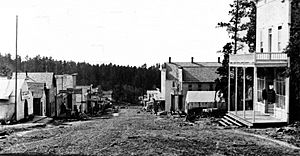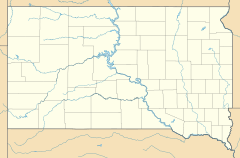Carbonate, South Dakota facts for kids
Quick facts for kids
Carbonate
Carbonate Camp, Virginia, West Virginia
|
|
|---|---|

Carbonate, 1890
|
|
| Country | United States of America |
| State | South Dakota |
| County | Lawrence County |
| Established | 1881 |
| Abandoned | 1939 |
| Founded by | James Ridpath |
| Named for | carbonate ore |
| Elevation | 5,558 ft (1,694 m) |
| Time zone | UTC-7 (MST) |
| • Summer (DST) | UTC-6 (MDT) |
Carbonate is a fascinating ghost town located in Lawrence County, South Dakota, United States. A ghost town is a place where most people have left, leaving behind empty buildings and a quiet history. Carbonate was once a busy mining town. It was also known by other names like Carbonate Camp, West Virginia, Virginia, and Carbonate City.
Contents
What's in a Name?
The town had a few different names over time. First, it was called West Virginia. Then, its name changed to Virginia. Later, it became known as Carbonate Camp and finally Carbonate. These names came from the carbonate minerals found there. These minerals were important for the town's mining activities.
A Town's Exciting History
Carbonate's story began around 1880. A man named James Ridpath was the first to settle in the area. He started the West Virginia Mine. There, he made an important discovery: carbonate ore. This ore was a mix of silver and lead. This find would soon make the town very successful.
The First Boom: 1881
Carbonate was officially founded in July 1881. This happened after a newspaper article told everyone about the rich ore. Many settlers quickly moved to the area. By August, about 200 men had arrived. They lived in tents and started searching for gold. A wagon road was also built to Spearfish that same month.
To help the town grow, a special fund was started in Deadwood. Soon, many businesses opened. These included shops, restaurants, and places for entertainment. There were also barber shops, laundries, and a drug store. The town even had its own newspaper, The Carbonate Reporter. However, by September, fewer new settlers were arriving.
Mining Challenges and a New Start
In June 1883, mining work stopped. The roads were in such bad shape that they could not be used. James Ridpath tried to attract new people. He even planted an apple orchard and a strawberry patch.
The town became busy again in 1885. This was when the nearby Iron Hill Mine started digging for gold and galena. Another famous mine was the Seabury-Calkins, sometimes called "Seabury-Coffin." This mine accidentally dug into the Iron Hill Mine. But during a mine fire, the Seabury-Calkins Mine actually became a way for miners to escape! Six other local mines also helped the town grow.
Carbonate's Golden Age
During this second boom, Carbonate added many new buildings. A hotel opened on May 1, 1886. There were also more stores, boarding houses for many workers, a post office, a church, and a bank. The town's second newspaper, The Nugget, started in 1886.
The biggest hotel in Dakota Territory was William Hugginson's Black Hills Hotel. It had three stories, a saloon, and a banquet room. In August 1886, the first school classes were held. A smelter, which processes ore, was built in 1887. The town also built a cemetery. By 1891, the Iron Hill Mine had made a profit of $667,000. At its busiest, Carbonate may have had between 2,000 and 3,000 people living there.
A Time of Sickness
In 1888 and 1889, a sickness spread through the area. Signs that said "Keep out: Black Diphtheria!" stayed up until 1910.
The Town's Decline
Silver prices started to drop in 1891. This caused all the mines, except Iron Hill, to close by 1904. Soon, most people left Carbonate. In 1900, the Hugginson Hotel was taken apart. Its wood was used for a nearby mill.
In 1901, the Iron Hill Mine was reopened. It produced more silver and lead. But in 1911, the mine accidentally flooded, forcing its owners to leave. The Iron Hill Mine kept working until the 1930s. Today, only one house and a mine structure remain from it. Carbonate's last resident, an elderly man named Raspberry Brown, passed away in 1939.
Where is Carbonate?
Carbonate is found in the Black Hills of western Lawrence County. The weather there is like the rest of western South Dakota. Summers are hot, and winters are very cold.
Carbonate is about 4 miles east of the ghost town of Maitland. It is near Squaw Creek. It is also about 5 miles north of Trojan. Spearfish is 10.5 miles southeast, and Central City is 7 miles northwest. The houses in Carbonate were spread out. The main part of the town was in an open valley. Today, only the foundations of the old buildings can be seen.



